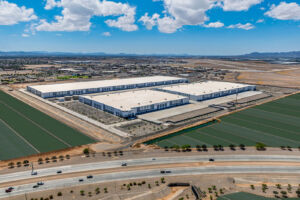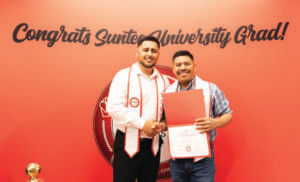Very few people can match Karrin Taylor Robson’s connection to downtown Mesa.
Young Karrin Kunasek grew up on 2nd Avenue and celebrated her only birthday party as a child at Pioneer Park. Her brother Andy was born at Southside Hospital, which is now home to Benedictine University’s Mesa campus.
Taylor Robson remembers rushing around downtown Mesa as a girl of 11 or 12, making deliveries for one of her father’s pharmacies. That particular pharmacy, Lewis Drug, was located where the Mesa Arts Center, the crowning jewel of downtown Mesa, now stands.
“Growing up, the Valley was Phoenix-Mesa,” said Taylor Robson, the founder and president of Arizona Strategies. “But at some point in time, the Mesa kind of got dropped off. There were a couple decades there where Mesa became a sleepy bedroom community. And then Mesa had a reawakening.
“Today, the stars are all aligning at a time when the Valley has regained our stride as a region and Mesa, if you ask most real estate groups where the next place that will be popping is, most will tell you it’s Mesa.”
Taylor Robson, a member of the Valley Partnership’s Honorary Board of Directors, is playing a big role in why Mesa is an exciting place to be. She is a principal in a development group behind a downtown Mesa mixed-use development project called The Grid. That project is just one of several currently in the works throughout the city. From the far west side of Mesa to the Phoenix-Mesa Gateway Airport in the East, development in Mesa is popping.
The roots of the boom
Mesa mayor John Giles, like Taylor Robson, is a Mesa native. He too remembers when the whole East Valley would come to downtown Mesa.
“Chandler didn’t have anything, Gilbert didn’t exist, Tempe, outside of ASU, was nothing, so downtown Mesa was the urban core,” Giles said. “As shopping malls became a reality, freeways became a reality, little by little, downtown Mesa went from a thriving economic area to kind of the opposite. I saw some dark days.”

The project that turned the tide was the Mesa Arts Center. The idea was hatched in 1998 but the building didn’t open until 2005.
“I was on that council back in 1998 that went to the voters to build the arts center,” Giles said. “The city started reinvesting in downtown.”
After the success of the arts center, more downtown activity followed, most importantly, the Valley Metro light rail line. That was followed by an influx of higher education to downtown in Benedictine University, opening the door for projects like bringing an Arizona State University building downtown as well as commercial and residential projects like The Grid.
“Mesa’s time has come downtown and I think the light rail is playing an important part,” Giles said. “When we talk about Arizona State coming downtown, they’ll tell you, if it wasn’t for the light rail coming downtown, we wouldn’t be having this conversation.”
West to East development
Count Craig Krumwiede, president and CEO of Harvard Investments, as a believer in the momentum in Mesa. Harvard Investments currently has two major developments in the city. In the West, Harvard Investments and Lincoln Property Company are involved in a joint development called Waypoint. In the East, Harvard Investments is developing Cadence, a 464-acre master-planned community that will eventually feature up to 3,500 residences, as well as retail, office, educational and commercial properties.

“I’ve been in business for 35 years and those are our first two projects in Mesa,” said Krumwiede. “We’ve been all over and all of the sudden, it seems like it’s Mesa’s time.”
Waypoint features 435,000 square feet of office space located just east of Mesa’s Riverview Park. Of that space, more than 75 percent is currently leased.
“The project was very well received,” Krumwiede said. “It went really nicely with the city, which has been great to work with.”
As the light rail line has continued to be developed eastward, that left some development opportunities along the line in west Mesa. Plans are currently being made for a mixed-use development at the old park and ride near West Main Street and Dobson Road. The project, Sycamore Station, would sit on more than 20 acres and feature residences, retail and office space.
“In planning terms, we call that a zoning bank and that was a portion of property for future development to grow,” said Jessica Sarkissian, founder and principal at The Planning Center and a member of the City of Mesa Planning and Zoning Commission. “Mesa has really taken advantage of those spots along the corridor. They’re just trying to find a happy medium between high-density commercial and mixed-use properties and the existing single-family residences that have been there a long time.”
Cadence sits just east of Phoenix-Mesa Gateway Airport, another part of Mesa that is seeing a rush of development plans.
“When we bought out Cadence project, Gateway was big for us,” Krumwiede said. “It was on our map for all of the things that are bringing jobs to the Valley.”
Other developments near Gateway have been thriving or are just getting rolling. Eastmark, owned by DMB, is one of the largest-selling master-planned developments in the nation. Sunbelt Holdings owns 270 acres that make up Mesa Elliot Technology Park in the Mesa Elliot Technology Corridor. Apple, Niagara Bottling and EdgeCore are already operating or have broken ground on large facilities in the corridor.

The most tantalizing economic development for the Gateway area is Skybridge Arizona, the nation’s first international air cargo hub that will streamline the customs process for air shipments between the United States and Mexico.
Put simply, Skybridge will be a joint venture between the two countries, with Mexican customs officials working out of the Skybridge center to pre-clear all of the cargo so that it can fly direct to one of the hundreds of airports throughout Mexico. The projected impact is enormous: 17,000 new direct and indirect jobs, an increase of 2,000 cargo flights per year from Gateway (reaching 10,000 flights by 2036), a need for 2 million square feet of warehouse space, 1 million square feet of office space as well as 900,000 square feet of light industrial and flex space, operations facilities, hotels, retail and restaurants. The 15-year build out plan also includes infrastructure improvements at and around the airport to accommodate this increase in commerce flowing through.
“Skybridge is a game-changer, not just for Mesa but the state of Arizona and the Southwest region as a whole,” said Bill Jabjiniak, Economic Development Director for the City of Mesa. “It’s going to bring e-commerce companies with large warehousing space needs, a demand for office and industrial spaces for growing industries.”
City center
While the Mesa Arts Center, light rail and the arrival of Benedictine University were the catalyst for a downtown Mesa rebirth, projects like The Grid aim to take the area to the next level.
The $60 million project is a joint venture between Palladium Enterprises, where Taylor Robson is a principal, the City of Mesa and Benedictine University.
The Grid will feature 75 urban flats, 196 apartments as well as 15 street-level row homes. It has already landed its first tenant in CO+Hoots, a leading collaborative co-working company based in Phoenix. CO+Hoots will occupy more than 13,000 square feet of space and will partner with Benedictine’s entrepreneurial leadership program and students will study and work at the facility.
There will also be retail and dining spaces as well as more office space to make The Grid a place people can work and live.
Taylor Robson is confident that The Grid can stand alone, but also knows what kind of impact adding an ASU building to the downtown core would have.
“The energy that comes with putting students in this environment is good for everyone – you don’t need to look any further than downtown Phoenix to see what ASU’s presence means to an area,” Taylor Robson said.
While the ASU project isn’t done and delivered, the city and university have reached an Intergovernmental Agreement. Mesa City Manager Chris Brady’s office is now working with ASU on a lease agreement and a construction budget.
Shortly after Mesa announced that agreement with ASU, Caliber, The Wealth Development Company, purchased eight buildings in downtown Mesa with the intent of renovating them.
“They’re smart people,” Giles said of Caliber. “It was inevitable, frankly, because people are going to make money in downtown Mesa.”
While making money on The Grid is part of the plan for Taylor Robson, it’s not the sole motivation. Her motivation was more personal. She wanted to breathe new life into an area she holds an affinity for.
“I’ve been at this for 24 years now and doing it for other people and loving every minute of it,” Taylor Robson said. “Professionally, I love driving around town and saying I had a little piece in that or a little bit to do with that. It’s fun to be able to physically look at your work.
“This one will be different because it’s my first development project where I’m a principal in the deal, it’s my hometown and it’s literally where I grew up.”



